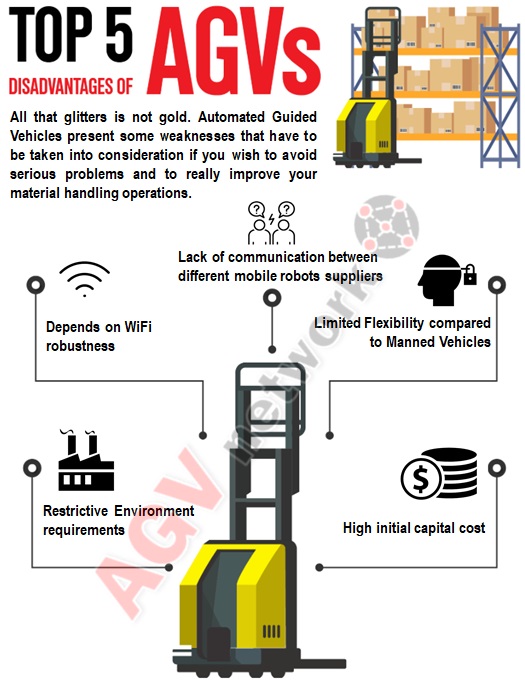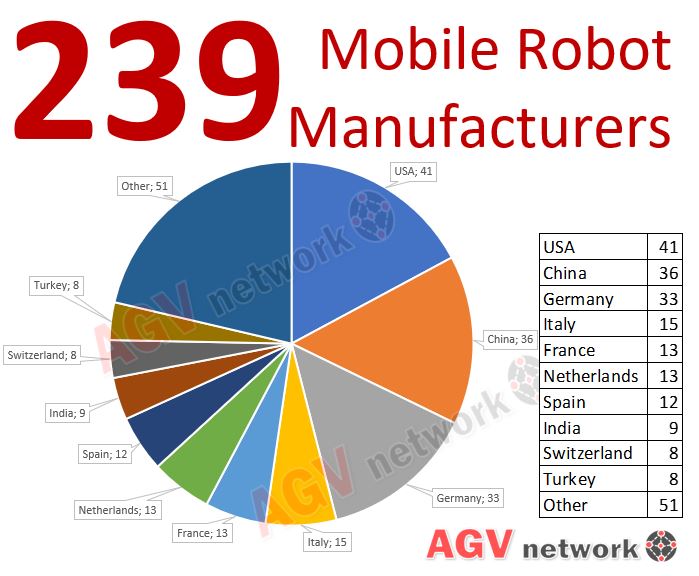AGV Disadvantages: 5 Cons of Autonomous Mobile Robots You Must Know.
Mobile Robots are great. They offer lots of advantages for warehouses and production facilities. They are efficient, effective and help with the bottom line. They are generally safer and work longer hours than the average employee. But!! All that glitters is not gold.
Check out these top 5 drawbacks of Automated Guided Vehicles before investing.
The top 5 AGV disadvantages that you cannot ignore
We sell AGVs & AMRs. So, we always promote automation solutions against traditional manned vehicles or other less automated solutions.
In fact, there are a bunch of good reasons for investing in mobile robots. Summed up, the main AGV advantages are related to money and safety.
On the other hand, Automated Guided Vehicles present some weaknesses or drawbacks that need to be taken into consideration if you want to avoid serious problems and actually improve your material handling operations.
What are the main disadvantages of AGV?
The main AGV disadvantages are:
Let’s dig deeper into the 5 main weaknesses of the Automated Guided Vehicles.

Dependency on WiFi Reliability
If your WiFi fails… be prepared for your worst nightmare ever.

In general, the AGV Systems utilize wireless communication technology to exchange information between the mobile robots, the AGV Management System, Fleet Management System and other external elements such customer ERP, WMS, OPCs, PLCs, etc.
This means that everything depends on the quality and robustness of your WiFi connection.
If your WiFi doesn’t work properly, your AGVs wouldn’t receive mission orders, navigate obstacles, or know where anything is located… so everything will STOP.
In the unlucky case of a WiFi communication shortage and if you rely on mobile robots, your production line will stop receiving raw materials, your warehouse will stop deliveries and operations, and your final product will not be despatched. Your entire product chain will grind to a fast, unfortunate, and unsympathetic stop.
I told you, a real nightmare.

Of course, if you have manual operated vehicles your operations can continue in some limited or unlimited ways.
Consider and remember that one of the keys to any successful AGV Systems is the quality and reliability of your wireless communications. This means having a robust installation of wireless APs (Access Points) and clients, enough to handle current communication and future communication needs.
Which is more appealing: saving money on routers only to have your entire operation shut down; or, spending a few extra bucks upfront as an insurance policy on future connectivity needs?
It’s complicated to introduce different mobile robot suppliers

An AGV supplier does not like to speak with another AGV supplier. I mean, they are probably best friends and speak often, in a pub, at an exhibition… but their AGV Systems do not really speak the same language.
If you choose a supplier, make sure your relationship is strong enough. You will want to “marry” him because it’s most likely too complicated to deploy a second supplier’s vehicles in the same working area.
Your AGV supplier will tell you: “Don’t’ worry, in case you add a different supplier in the future, we’ll find the way to collaborate.” Don’t fall for this.
Be careful. It will either be very expensive or technically impossible.
If you have two different suppliers, with two different management systems:
- Who commands?
- Who assigns the missions?
- Who manages the priorities?
- How do the robots behave at an intersection?
An AGV manufacturer has two options when deciding on what AGV Management System is necessary for its mobile robot range and requirements.
The AGV Manufacturer opts to develop its own fleet and management system
If your supplier is in this group… well, it will be really complicated to interface its system with a different one.
You will probably need a software integrator, a bridge…
The AGV Manufacturer opts to buy a commercial management system
It can buy and implement a commercial AGV system from a company that specifically develops AGV Management Systems. These platforms are available from all the AGV suppliers.
If your supplier is in this group, things could be easier because these platforms are somehow thought to work with different brands of robots.
If you are lucky and your second supplier uses the same software platform used by the first one, well, it’s almost done. You have one management system managing different vehicles. There will need to be some modifications, but it shouldn’t be a huge problem.
Limited flexibility compared to manned vehicles.

This is one of the main disadvantages of AGVs compared to manual means.
A human operator can react and change his task in a second. He can go faster, slower, pick material from a given position , then go to another one (even if he has never gone before) he hasn't to respect tight tolerances to pick material.
Wait! I’m not talking about efficiency. Maybe this flexibility is not efficient, but it allows for the performance of different tasks.
AGVs are less suitable for non-repetitive tasks.
Sometimes, operations require flexibility and the instantaneous capacity to change or to jump between tasks as is needed.
Every AGV supplier will tell you that their AGV Systems are flexible, as well as easy to maintain and modify.
Well, the truth is: that isn’t always the case.
Manually operated vehicles are much more flexible than AGVs. AGVs perform defined tasks. They will not do anything more than that. Humans can pivot based on the needs of the situation. Robots have to be told by an operator or some other highly intelligent algorithm.
For example a forklift operator could perform a defined job for 85% of his time, and in the remaining 15% that operator could move many other different things, without any real criteria.
When we decide to substitute the 85% of tasks with an unmanned AGV, we calculate (for example) 18 months payback. It seems reasonable!
The problem is that the remaining tasks (those needing 15% of the time) must be done anyway and could need a huge AGV extra investment or may not even be possible to automate (so you need to keep the human-operated on staff).
In many cases, AGVs are not convenient because of their lack of flexibility (or high investment needed to provide extra flexibility).
Manual forklifts move materials with different formats, tac times, etc. Human-manned vehicles can handle different sized loads and pallets, and they are flexible at handling independent jobs from a given order list based on the circumstantial needs of the warehouse. A human operator can give help on a big order in a pinch. Robots need to be reprioritized.
It could be complicated to modify AGVs orders to accommodate new products/loads, or needs of the facility.
Another AGV disadvantage related to flexibility regards to the programmed path or route. If it needs to be altered quickly due to a new layout, or other unforeseen issues, it can take some time to halt operations and reprogram the AGV to adapt to the new workflow.
Of course, it does depend on the type of AGV. In case you have an Autonomous Mobile Robot, this modification could be done easily.
High Initial Capital Cost of the AGV System

One of the main benefits of AGVs is that they increase overall efficiency and productivity driving to economic advantages.
The problem is that purchasing an AGV System, in the short term, is more expensive than hiring personnel or using other equipment such as manual forklifts.
You will usually need some time to payback your investment, and you know better than me, it is not always possible to have cash available for such an investment.
Do not miss our Automated Guided Vehicle ROI Ultimate calculator
While automation is intended to replace non value-added costs, AGVs become more and more interesting while increasing the number of working hours. Of course, 3 shift operations are much more appealing for an AGV system.
Remember that one AGV will never (almost) substitute one human-manned vehicle. Human-manned vehicles operate at a higher speed compared to AGVs. If you needed one human, you’d probably need 1.5 or 2 AGVs.
In other words, your cost of the AGV System is the same if you work 8 hours or 24 hours a day.
Restrictive environment requirements
Mobile Robots require highly specific working environments. Unfavourable environment conditions could limit the AGV performance or block it.
If you have manual vehicles, you may never worry about these issues.
When you’ll receive an AGV offer, you’ll probably receive a list of environment constraints required by the manufacturer to make sure that the AGV system works properly.
I have to admit that in many cases these specifications are very restrictive and are issued to protect the AGV manufacturer. I’ve seen AGVs working in absolutely non-appropriate areas, but it’s all at your own risk.
These are some of the main environmental constraints.
The floor
The floors must not be too uneven, and every transition from one surface, height etc. to another needs to be taken into consideration.
Construction or expansion joints should be eliminated or reduced. Floors should be as seamless as possible.
This is important because vibrations could create problems to electronic devices and connectors.
Flatness and levelness. Appropriate flatness and levelness are imperative for the safe and efficient operation of an AGV warehouse facility.
Flatness and levelness are basic to grant material deposit and picking with proper tolerance. You don’t want a robot unsteady while picking at high heights.
Abrasion resistance, gloss factor and Friction. Floors must not be too smooth nor too slippery or too rough.
Proper roughness is fundamental to avoid AGV slips in case of sudden stops. The safety system intervention software relies on proper roughness for stopping power.
Do not forget to check floor for electrical conductivity. If floor is completely isolated, your vehicles could be charged with electrostatic energy that could compromise your vehicle electronics.
Ambience Light and Dust
Safety AGV Laser and Navigation AGV sensors could be obscured by environment light or dust. AGV suppliers will specify a defined number of lumens for ensuring that lasers are not blinded.
There are some other constraints to be taken into consideration. Make sure that your working environment is appropriate if you wish to have AGV system working as long as possible.
Keep on learning! More related articles:
Warehouse Automation Trends - Do you know what are the top 7 warehouse automation trends?
11 Explained Advantages of Automated Guided Vehicles (AGV) It’s not all about costs
AGV ROI and Payback - Download our free Payback Calculator
Advantages of Robotics as a Service – RaaS Gives Instant Return on Investment for AGVs and AMRs
Warehouse Robotic Forklifts - High reach and payloads are not a problem anymore for Robotic forklifts in warehouses
Autonomous Mobile Robots applications - Autonomous navigation allows huge flexibility and incredible new applications
Autonomous Mobile Robots in Warehouse - AMRs bring awesome advantages to ecommerce distribution centres

